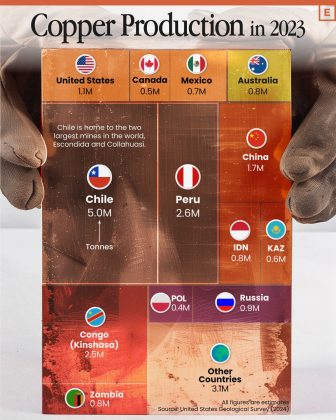
In the rapidly evolving global energy landscape, one metal is emerging as a critical player: copper. Known for its excellent conductivity and versatility, copper is essential in numerous industries, particularly those driving the transition to renewable energy. Copper is now worth its weight in gold, with criminals even trying to cash in on its increasing value. But what’s behind the soaring prices of copper, and why does the metal have an indispensable role in our energy evolution?
The Essential Metal for a Cleaner Energy Future
Copper is more than just a penny’s worth in today’s economy; it’s a fundamental part of modern infrastructure. From electric vehicles (EVs) and power cables to wind farms and solar panels, copper is crucial to advancing renewable technology, transporting that energy, and even storing it for later. The metal’s high conductivity is ideal for efficient electricity transmission, a key requirement for EVs and renewable energy systems. For instance, EVs need about four times more copper than traditional gas-fueled cars. Wind and solar farms also require significantly more copper than coal power plants.
As communities look towards electrification, the demand for copper is poised to skyrocket. By 2031, it’s projected that over 36 million metric tons of copper will be required annually to bolster electrification initiatives. However, the supply is anticipated to fall short, creating a significant gap that could have profound implications.
Producing enough first-generation renewable technology to replace fossil fuels would take 4.3 billion tons of copper, according to Simon Michaux, an associate professor of geometallurgy at the Geological Survey of Finland. Adding insult to injury, Robert Bryce notes, “At current rates of production, that much copper would take 180 years (to produce).”
The Supply and Demand Challenge
Various factors are fueling the escalating demand for copper. The Inflation Reduction Act, for instance, has channeled federal funds into green energy and electrification projects, amplifying the need for copper in all of the anticipated renewable programs championed by the Administration. As of May, copper was trading at over $4.65 per pound, a significant surge from previous years, with expectations of further price hikes.
However, the supply side faces considerable challenges. Mining companies are struggling to keep up due to a shortage of workers, regulatory hurdles, and environmental and social concerns. Opening new mines is expensive and time-consuming. That’s because getting a mining permit in the U.S. takes, on average, 7 to 10 years to secure – one of the world’s longest permitting processes – and once a permit is issued, it still often takes around 10 more years before minerals are being produced. Moreover, high-grade copper resources

are not abundant and are typically located in geographically and politically challenging regions. So much of what is left is low-grade and does not meet the standards needed for manufacturing.
While high-grade copper is still out there, it would benefit our own communities at the detriment of others, mostly in impoverished areas of Chile and Peru — two of the largest copper-producing countries in the world.
Industry Response and Future Outlook
The mining industry has seen a wave of consolidation in response to the looming shortage. Major international companies like Glencore, BHP, Rio Tinto, and Newmont are acquiring other mining operations to access copper deposits quickly. Yet, these mergers cannot produce copper without an operating mine, and new mines will be necessary. As of February 2024, the price of copper was $8,304.95 per metric ton. Analysts predict that copper prices would need to rise to $15,000 per metric ton to attract the necessary investment in new mining projects – a 57% increase.
Despite these efforts, the path forward is full of obstacles. Environmental and social scrutiny is increasing, making opening new mines more complex. In spite of the need, the Biden Administration canceled leases for copper and nickel mining that had been held for over 50 years. Shortly after, the Administration paused mineral leasing on over 200,000 acres of land in the Superior National Forest, seeking a 20-year prohibition on mining, which it enacted in January. In response, companies like Tesla are attempting to reduce copper usage in their products, but such changes may not suffice to meet the growing demand.
Copper’s vital role in renewable energy technology and electrification cannot be overstated. Copper carries 100% of its energy current than any other metal, making it extremely efficient and essential for electric vehicles, renewable energy systems, and modern infrastructure. However, the current supply-demand imbalance drives up prices and creates uncertainty in industries that utilize the metal. To meet the escalating demand, substantial investment in new mining projects and innovative solutions to reduce copper usage will be essential. As we navigate this complex landscape, the future of copper will significantly influence the pace and success of the global energy evolution.
Two university professors from Michigan and Cornell break it down further here, highlighting all of the areas that will require copper to advance our national goals. As we continue to create mandates and reduce consumer choice, there will continue to be unintended consequences. Consumer Energy Alliance continues to advocate for responsible choices that balance our need for energy and environmental protection.











